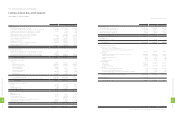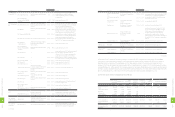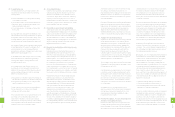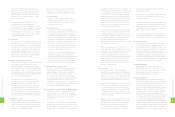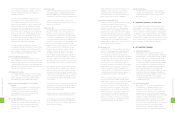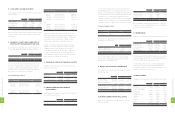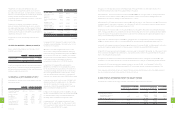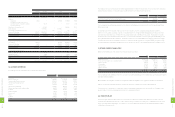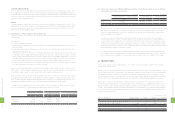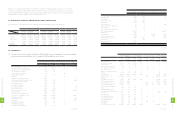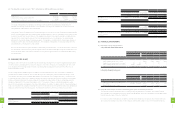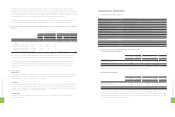HTC 2012 Annual Report Download - page 108
Download and view the complete annual report
Please find page 108 of the 2012 HTC annual report below. You can navigate through the pages in the report by either clicking on the pages listed below, or by using the keyword search tool below to find specific information within the annual report.
All subsidiaries file income tax returns based on the
regulations of their respective local governments.
In addition, there is no material difference in the
accounting principles on income taxes between the
parent company and those of its subsidiaries.
(24) Stock-based Compensation
Employee stock options granted on or after January
1, 2008 are accounted for under SFAS No. 39 -
"Accounting for Share-based Payment." Under the
statement, the value of the stock options granted,
which is equal to the best available estimate of the
number of stock options expected to vest multiplied
by the grant-date fair value, is expensed on a straight-
line basis over the vesting period, with a corresponding
adjustment to capital surplus - employee stock options.
The estimate is revised if subsequent information
indicates that the number of stock options expected to
vest differs from previous estimates.
(25) Treasury Stock
Under SFAS No. 30 - "Accounting for Treasury Stocks,"
when the Company acquires its outstanding shares
that have not been disposed or retired, treasury
stock is stated at cost and shown as a deduction in
stockholders' equity. When treasury shares are sold, if
the selling price is above the book value, the difference
should be credited to the capital surplus - treasury
stock transactions. If the selling price is below the
book value, the difference should first be offset against
capital surplus from the same class of treasury stock
transactions, and the remainder, if any, debited to
retained earnings. The carrying value of treasury stock
is calculated using the weighted-average approach in
accordance with the purpose of the acquisition.
When the Company's treasury stock is retired, the
treasury stock account should be credited, and the
capital surplus - premium on stock account and capital
stock account should be debited proportionately
according to the share ratio. The carrying value of
treasury stock in excess of the sum of its par value
and premium on stock should first be offset against
capital surplus from the same class of treasury stock
transactions, and the remainder, if any, debited to
retained earnings. The sum of the par value and
premium on treasury stock in excess of its carrying
value should be credited to capital surplus from the
same class of treasury stock transactions.
(26) Reclassifications
Certain 2011 accounts have been reclassified to be
consistent with the presentation of the consolidated
financial statements as of and for the year ended
December 31, 2012.
3. TRANSLATION INTO U.S. DOLLARS
The consolidated financial statements are stated in New
Taiwan dollars. The translation of the 2012 New Taiwan
dollar amounts into U.S. dollar amounts are included solely
for the convenience of readers, using the noon buying rate
of NT$29.129 to US$1.00 quoted by Reuters on December 31,
2012. The convenience translation should not be construed
as representations that the New Taiwan dollar amounts have
been, could have been, or could in the future be, converted
into U.S. dollars at this or any other exchange rate.
4. ACCOUNTING CHANGES
(1) Financial Instruments
On January 1, 2011, the Company adopted the newly
revised SFAS No. 34 - "Financial Instruments: Recognition
and Measurement." The main revisions include (1) finance
lease receivables are now covered by SFAS No. 34; (2)
the scope of the applicability of SFAS No. 34 to insurance
contracts is amended; (3) loans and receivables originated
by the Company are now covered by SFAS No. 34; (4)
additional guidelines on impairment testing of financial
assets carried at amortized cost when a debtor has
financial difficulties and the terms of obligations have been
modified; and (5) accounting treatment by a debtor for
modifications in the terms of obligations. This accounting
change had no material effect on the Company's
consolidated financial statements as of and for the year
ended December 31, 2011.
(2) Operating Segments
On January 1, 2011, the Company adopted the newly
issued SFAS No. 41 - "Operating Segments." The
requirements of the statement are based on the
information on the components of the Company that
management uses to make decisions about operating
matters. SFAS No. 41 requires identification of operating
segments on the basis of internal reports that are
regularly reviewed by the Company's chief operating
decision maker in order to allocate resources to the
segments and assess their performance. This statement
supersedes SFAS No. 20 - "Segment Reporting"
and resulted in the Company's compliance with the
requirement to disclose operating segment information.
extent that an impairment loss on the same revalued
asset was previously charged to earnings. Any excess
amount is treated as an increase in the unrealized
revaluation increment.
For the purpose of impairment testing, goodwill is
allocated to each of the relevant cash-generating
units ("CGUs") that are expected to benefit from the
synergies of the acquisition. A CGU to which goodwill
has been allocated is tested for impairment annually
or whenever there is an indication that the CGU may
be impaired. If the recoverable amount of the CGU
becomes less than its carrying amount, the impairment
is allocated to first reduce the carrying amount of the
goodwill allocated to the CGU and then to the other
assets of the CGU pro rata on the basis of the carrying
amount of each asset in the CGU. A reversal of an
impairment loss on goodwill is disallowed.
For long-term equity investments on which the
Company has significant influence but over which it has
no control, the carrying amount (including goodwill) of
each investment is compared with its own recoverable
amount for the purpose of impairment testing.
(18) Accrued Marketing Expenses
The Company accrues marketing expenses on the
basis of agreements and any known factors that would
significantly affect the accruals. In addition, depending
on the nature of relevant events, the accrued marketing
expenses are accounted for as an increase in marketing
expenses or as a decrease in revenues.
(19) Warranty Provisions
The Company provides warranty service for one year
to two years. The warranty liability is estimated on the
basis of evaluation of the products under warranty,
past warranty experience, and pertinent factors.
(20) Provisions for Contingent Loss on Purchase
Orders
The provision for contingent loss on purchase orders
is estimated after taking into account the effects
of changes in the product market, evaluating the
foregoing effects on inventory management and
adjusting the Company's purchases.
(21) Product-related Costs
The cost of products consists of costs of goods sold
(materials, labor and allocated manufacturing cost),
inventory write-downs (or reversal of these write-
downs), warranty expenses and contingent loss on
purchase orders.
(22) Pension Plan
Pension cost under a defined benefit plan is determined
by actuarial valuations. Contributions made under a
defined contribution plan are recognized as pension
cost during the year in which employees render services.
Curtailment or settlement gains or losses on the
defined benefit plan are recognized as part of the net
pension cost for the year.
(23) Income Tax
The Company applies the intra-year and inter-year
allocation methods to its income tax, whereby (1)
a portion of income tax expense is allocated to the
cumulative effect of changes in accounting principles
or charged or credited directly to stockholders' equity;
and (2) deferred income tax assets and liabilities are
recognized for the tax effects of temporary differences,
unused loss carryforwards and unused tax credits.
Valuation allowances are provided to the extent, if any,
that it is more likely than not that deferred income
tax assets will not be realized. A deferred tax asset
or liability is classified as current or non-current in
accordance with the classification of the related
asset or liability for financial reporting. However, if a
deferred income tax asset or liability does not relate
to an asset or liability in the financial statements, it is
classified as current or non-current on the basis of the
expected length of time before it is realized or settled.
If the Company can control the timing of the reversal
of a temporary difference arising from the difference
between the book value and the tax basis of a long-
term equity investment in a foreign subsidiary or joint
venture and if the temporary difference is not expected
to reverse in the foreseeable future and will, in effect,
exist indefinitely, then a deferred tax liability or asset is
not recognized.
Tax credits for purchases of machinery, equipment and
technology, research and development expenditures,
and personnel training expenditures are recognized
using the flow-through method.
Adjustments of prior years' tax liabilities are added to
or deducted from the current year's tax provision.
According to the Income Tax Law, an additional tax
at 10% of unappropriated earnings is provided for as
income tax in the year the stockholders approve the
retention of these earnings.
2
1
2
8
FINANCIAL INFORMATION
2
1
3
8
FINANCIAL INFORMATION



